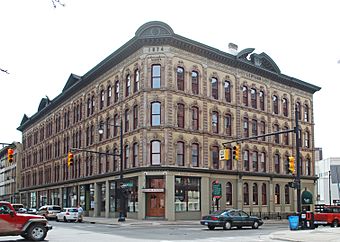Ledyard Block Historic District facts for kids
Quick facts for kids |
|
|
Ledyard Block Historic District
|
|
 |
|
| Location | 123-145 Ottawa Ave., and 104-124 Monroe Center, NW, Grand Rapids, Michigan |
|---|---|
| Area | 1 acre (0.40 ha) |
| Built | 1859 |
| Architect | William G. Robinson |
| Architectural style | Late Victorian, Italianate |
| NRHP reference No. | 83000878 |
| Added to NRHP | September 8, 1983 |
The Ledyard Block Historic District is a special group of seven old buildings in Grand Rapids, Michigan. These buildings were all designed in a similar style during the 1800s. You can find them at 123-145 Ottawa Avenue and 104-124 Monroe Center, NW. This collection of buildings was added to the National Register of Historic Places in 1983. This means they are important historical places worth protecting.
Contents
A Look Back: The Story of Ledyard Block
In September 1857, a big fire destroyed about 25 buildings in Grand Rapids. This happened along Monroe Avenue. But people quickly started rebuilding the area. They put up new shops and offices.
The first new building was the Ledyard and Aldrich Block. It was built in 1859. Two important businessmen, William B. Ledyard and Moses V. Aldrich, owned it. They built it as an investment property. The first floor had stores, and the upper floors had offices and a place for people to live. Other business owners soon built their own buildings nearby. William Ledyard then built another large building in 1874. It was called the Ledyard Block.
What Makes These Buildings Special?
The Ledyard Block Historic District has seven buildings. They were built in three main stages.
The First Building: Flatiron Building
The very first building was the Ledyard and Aldrich Block. Today, it is known as the Flatiron Building. It is located at 102-108 Monroe Center, N.W. This building was constructed between 1859 and 1860. It has four stories and is made of brick. It was built in the Italianate style, which was popular then. This style often includes decorative details and tall windows. The building has a rounded corner where two streets meet. It also has a roof edge that sticks out, supported by large wooden brackets.
Five Similar Buildings
The second group of buildings includes five similar ones. They are located next to each other at 112, 114, 116, 118, and 122-24 Monroe Center. All of these were built around 1860. Each of these buildings also has four stories and is made of brick. They are also in the Italianate style. They look similar to the Flatiron Building, but some have fewer fancy details. These buildings were originally built for different local businessmen.
The Final Ledyard Block
The last building added to the district was the Ledyard Block itself. It was built in 1874 at 123-145 Ottawa Avenue. This building also has four stories. It is made of yellow brick and is very long. It has special stone bands and window frames made from Ionia sandstone. Metal decorations run along the top of the building.

